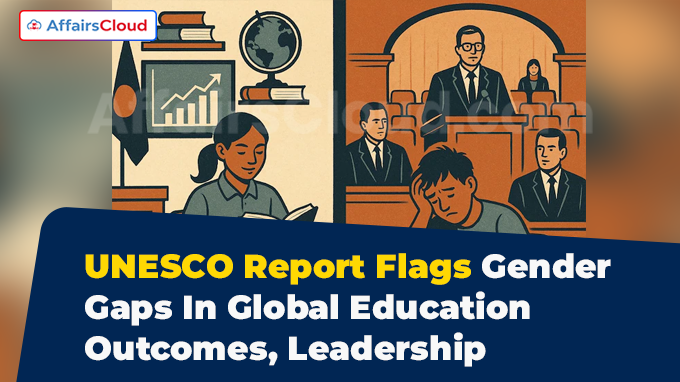 In June 2025, Paris (France)-based United Nations Educational, Scientific and Cultural Organisation (UNESCO) published its latest “Global Education Monitoring (GEM) Report for 2024-25: Leadership in education- Lead for Learning”. The report has flagged serious concerns over gender disparities in both education outcomes and leadership positions across countries, including India.
In June 2025, Paris (France)-based United Nations Educational, Scientific and Cultural Organisation (UNESCO) published its latest “Global Education Monitoring (GEM) Report for 2024-25: Leadership in education- Lead for Learning”. The report has flagged serious concerns over gender disparities in both education outcomes and leadership positions across countries, including India.
- The report highlighted that boys continue to lag behind girls in reading proficiency across the world. It further revealed that on average, only 87 boys attain the minimum proficiency level for every 100 girls.
- However, this gap is wider in Middle-Income Countries (MICs), where only 72 boys meet reading standards per 100 girls.
Key Findings:
i.Lack of Reading Proficiency in Developing Countries: As per the report, 73% of children in developing countries are unable to read and comprehend a simple text by age 10, a key indicator of learning poverty that reflects the gap between schooling and actual learning.
ii.COVID-19 Pandemic Disrupts Gender Parity in Mathematics: The report noted that gender parity in mathematics has held for 20 years, but latest data from the 2023 Trends in International Mathematics and Science Study indicates that the COVID-19 pandemic may have reversed this balance.
- Girls in countries like Brazil, Chile, England, Italy, and New Zealand have shown underperformance in mathematics compared to boys.
iii.Gender Gap in Academic Leadership: The report showed that gender disparity in academic leadership can be witnessed in most countries. Women account 57% of secondary school teachers worldwide, but in most countries, the share of female principals lags the share of female teachers by at least 20 basis points (bps).
- Women account 45% of higher education faculty globally, and they represent only 30% of leadership roles in universities and colleges.
- In India, while women make up 60% of elementary school teachers, they accounted for only 13% of vice-chancellors in central universities as of 2022, highlighting a stark gender gap in educational leadership.
iv.Lack of women Political Leadership in Education: Only 27% of education ministers globally were women, between 2010 and 2023.
v.Competitive School Leader Recruitment Processes: As per the report, only 63% of countries worldwide have open and competitive school teacher recruitment processes.
- In India, the appointment process for teachers or principals varies across states. In so many cases, principals are appointed based on seniority or administrative credentials rather than demonstrated leadership or instructional ability.
- Moreover, only 31% of countries have formal induction systems for school principals while, India does not have a national framework for the purpose.
vi.Overburden of administrative work on school leaders: A survey cited in the report revealed that principals in 14 MICs spend nearly 68% of their time on routine administrative duties.
- In India, principals are over burden by duties such as data reporting, mid-day meal coordination, exam administration, thus reducing their focus on academic leadership and teacher mentoring.
vii.Lack of women Leadership in Education in India: In India, 60% of elementary teachers are women. However, women representation decline sharply in leadership positions, particularly at secondary and tertiary levels.
- As per the report, only 5% of women held top academic positions such as vice-chancellors or directors and 2% as registrars in 189 Indian institutions in 2021.
- Also, among 1,220 universities, just 9% were women-chancellors, and 11% women held registrar or top administrative positions.
- The report outlined factors responsible for under-representation of women in higher academic roles such as: limited access to mentorship, lack of institutional support, safety concerns, and deep-rooted gender norms.
Other Key Findings:
i.As per the 251 million children and youth worldwide remain out of school, reflecting a marginal decrease of just 1% since 2015, of which 129 million are boys and 122 million are girls.
ii.Globally, public education expenditure has decreased by 40 bps of Gross Domestic Product (GDP) between 2015 and 2022: the average declined from 4.4% to 4%.
- Education spending per child has largely remained stagnant since 2010.
- Also, the share of aid going to education declined from 9.3% (in 2019) to 7.6% (in 2022).
iii.The report has outlined four recommendations that focus on actions government can take to foster leadership in education at school and the civil service.
About United Nations Educational, Scientific and Cultural Organisation(UNESCO):
Director-General (DG)- Audrey Azoulay
Headquarters- Paris, France
Established- 1945




